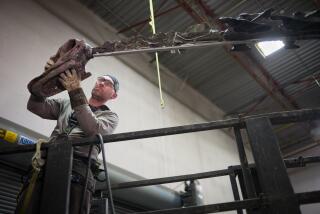A new chapter in science and technology at Huntington Library
Science historian Dan Lewis opened the green cloth cover of “The Origin of Species,” Charles Darwin’s classic work on evolutionary biology, and flipped to Page 20.
And there, in the 11th line of text, was the telltale typo: “Speceies.”
That misprint marked the book as one of the 1,250 copies originally published in London in 1859.
“If you’re at a garage sale and you see an old copy, check for this,” said Lewis, an expert on the history of science and technology at the Huntington Library in San Marino.
Darwin’s book is part of a consolidation of the Huntington’s collection of rare science books with the 67,000-volume Burndy Library, which had been housed at MIT.
Roughly one-fifth of the Huntington’s holdings came through its 2006 acquisition of the Burndy collection, amassed by Bern Dibner, an electrical engineer and scholar who made a fortune after inventing the first solderless electrical connector in 1924.
The gift was made on the condition that the Huntington create a permanent exhibit on the history of science and technology. That promise is set to be fulfilled today with the opening of “Beautiful Science: Ideas That Changed the World,” a permanent exhibit dedicated to books, manuscripts, letters and scientific devices that tell the history of discovery in the fields of astronomy, natural history, medicine and light.
Early theories
Among the featured items will be a 1279 version of “Almagest” (“The Greatest”) by the ancient Roman astronomer Ptolemy that described how the sun, planets and the rest of the universe revolved around the Earth, along with Copernicus’ 1566 “De Revolutionibus” (“On the Revolutions of the Heavenly Spheres”), which debunked that theory and placed the sun at the center of the solar system.
Henry E. Huntington, the railroad and real estate magnate who established the library in 1919, had a particular interest in the earliest books published after Johannes Gutenberg invented the printing press more than 550 years ago, Lewis said. A disproportionate number of those early books happened to be about science.
Science “was people’s way to attempt to understand the world,” he said.
The invention of the printing press coincided with a period of global voyage and exploration. Those efforts produced new information that was written down and disseminated through books, Lewis said.
As books became more common, topics in science remained popular. Part of the reason was their widespread appeal. “What the moon looks like under magnification is a pretty universal topic -- it looks the same everywhere,” Lewis said. “How the heart works -- that’s pretty universal.”
Weeks before the opening at the Huntington, poster-sized images illustrating some of science’s greatest hits were arrayed on countertops in the exhibition staging area next to Lewis’ office.
One striking figure from a 1746 anatomical reference book depicted a young woman with a serene gaze despite the fact that her back was sliced open to reveal her spine, rib cage and the blood-red sinews that surround them.
Nearby was a print of the first diagnostic X-ray, which revealed tiny pieces of buckshot scattered throughout the hand of a patient believed to have been injured in a hunting accident.
Against the walls were rows of books, including “Sidereus nuncius,” or “Starry Messenger,” a 1610 treatise by Galileo that Lewis described as “the birth announcement for the telescope.”
Newton’s notes
Then he thumbed through one of the most influential science books of all time, Isaac Newton’s “Principia Mathematica,” or “Mathematical Principles of Natural Philosophy.”
This 1687 volume -- Newton’s personal copy -- had about half a dozen notes scribbled in the margins, usually to correct equations.
A beat-up metal book truck was piled high with copies of “Origins of Species” in about 10 languages. When the exhibit opens, 250 of the books will go on display.
“It’s a way of showing how much it has spread throughout the world,” Lewis said.
The woman who first translated the book into French disagreed with some of Darwin’s observations about evolution and recast them in her translation, earning Darwin’s scorn, Lewis said.
On the other hand, the original German translator “worshiped Darwin,” Lewis said. “He tried to boost Darwin’s claims in a way Darwin didn’t agree with either.”
Though books form the core of the exhibit, Lewis also commissioned replicas of key scientific instruments, including the 17th century microscope through which English scientist Robert Hooke observed that cells are the building blocks of biological organisms. Visitors will be able to peer through it, along with a tiny microscope designed by Antoni van Leeuwenhoek, the father of microbiology.
Those who’d rather gaze at the heavens can view a plaster-of-Paris moon through a replica of Galileo’s telescope or a camera obscura.
A mural will serve as a time machine, taking viewers to 5:45 a.m. on Jan. 25, 1605, when the exploding Keppler supernova dominated the southeastern sky above the land where the library stands today.
Karen Kaplan is a Times staff writer.







